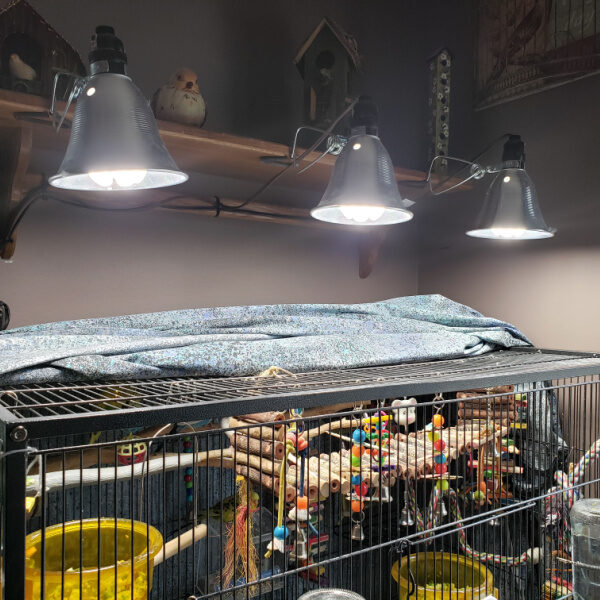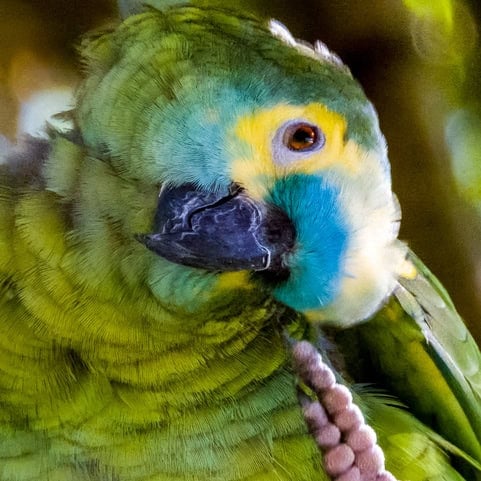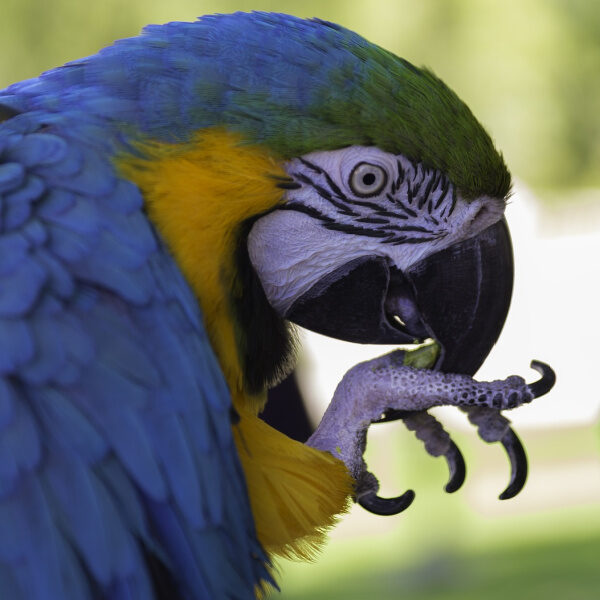Last Updated on by Mitch Rezman
Why is it so important to understand the differences between bird species?
I’m not ashamed to say we get more deliveries from Amazon (like most Americans) then we care to talk about.
This week a new Amazon driver “Patrick” handed off an envelope then said “I’ve never been here before – this place looks cool.”
He went further to explain why the place looked so cool.
“I’m thinking of getting a talking bird, one of those rainbow-colored ones, what are they called, macaws”?
“Here’s my card Patrick reach out when you’re ready to have a discussion.”
And so it goes.
Macaws are a good place to start a discussion about this conundrum.
Macaws – we’ve identified at least 43 species.
Hyacinth macaws are 44 inches long and have considerable weight like as much as 2500 g
Hahn’s macaws are the size of a sun conure about 165 grams and 12 -14 inches in length.
“I want a conure” someone blurts out from the studio audience.
“Sure”, I say, “Would that be a 64 g longtail bird like a Green Cheek conure or a Patagonian conure, close to the size of a Timneh African Grey?”
I’ve heard it said far too often “If you’re going to get your first parrot, volunteer at a bird rescue.”
My response will be if you’re going to have a child volunteer in an orphanage.”
That concept is patently absurd.
What makes more sense is to visit a bird rescue spending some time to understand the unique characteristics of 500 to 600 species of parrots and parakeets.
Umbrella cockatoos generally speaking are loud.
Major Mitchell cockatoos are not – generally speaking.
There’s no predicting a bird’s behavior in any given environment.
They take in and process more visual information than some early supercomputers.
Some species fly better than others.
Cockatiels are aerial acrobats.
Senegal’s will lumber across a room.
Ironically unlike dogs and cats, most pet birds within their species all look alike.
There’s no predicting that one bird in a particular bird species will act or react like another bird in the same species.
It’s important to not let your emotions get involved when choosing a bird.
You may have a romantic notion that big birds like an Umbrella cockatoo or Greenwing macaw would be a beautiful accessory in your home.
This notion might get reversed after about three days when you realize the size of the poop in the mess on the floor around the cage.
Editors note: you don’t like to vacuum don’t get a bird. Endnote
Other species of birds in a home may or may not react well together.
Conures are from South America.
Cockatiels are from Australia.
Ringnecks are from Africa and Asia.
Think about three foreign exchange students coming from the same three continents and sharing a dorm room.
How well will the three cohabitate?
It’s anybody’s guess – much like three birds and three cages in a room.
Some African grays have selected bonding, others bond with everyone in the family.
Senegals tend to be one-person birds.
Ringnecks like to enjoy the company of anyone engaging them (in most cases).
The species of birds in your home can be driven by other lifestyle goals.
A small aviary with a dozen finches will be a “living decorative accessory” while being low-maintenance.
You can replicate the same oral with 10 budgies but you are ramping up the mess exponentially.
Conures are noisy vocal birds.
Meyers parrots are not.
Housing (cages) is an entirely different issue.
The common mantra on the Internet is “Buy the biggest cage you can afford.”
If I’m a billionaire I’ll buy a cage the size of Cleveland (exaggerated to make a point).
We have an African Ringneck parrot with an upstairs 31 x 20 x 53-inch high cage where he lives with the doors open from 7:30 to 7:30 if I’m working upstairs.
When I’m away he moves down to his 22 x 17 x 31-inch high cage in the store so he can greet customers.
In an active household where people stay up late, you can put a big bird in a small cage at night for sleeping purposes.
If your bird travels with you as ours does you might want an additional cage for the car.
There are no cage rules except for maybe bar spacing but that’s an entirely different discussion.
Important to take into account the species when determining its nutrition program.
Larger birds have higher caloric needs than small ones.
Editors note. Birds that have clipped wings and experience no flight are going to burn fewer calories than birds who are allowed to fly about the house or a particular room. Endnote.
Get a dog buy a tennis ball and grab an old sock.
With birds, it’s nowhere near that easy.
Some species are chillers others are not.
Lovebirds like to play with toys hung on the side of the cage.
Parrotlets although the same size as lovebirds require larger cages and more toys throughout the cage.
In many cases, budgies will warm up to people and naturally socialize.
Parrotlets and lovebirds, if not socialized daily become scissors with wings.
I hope this is enough to get the conversation rolling.
Reach out if you have a species-specific question
Author Profile
Latest entries
 The Traveling BirdJune 26, 2025Can You Name 5 Parrot Species That Are Living Wild in the USA?
The Traveling BirdJune 26, 2025Can You Name 5 Parrot Species That Are Living Wild in the USA? Bird BehaviorJune 26, 2025How is it Parrots Are Problem Solvers Social Animals and Even Use Tools?
Bird BehaviorJune 26, 2025How is it Parrots Are Problem Solvers Social Animals and Even Use Tools? Bird & Parrot AnatomyJune 25, 2025How a Tiny Chemical Modification Makes Parrots Nature’s Living Paintings
Bird & Parrot AnatomyJune 25, 2025How a Tiny Chemical Modification Makes Parrots Nature’s Living Paintings PigeonsJune 20, 2025How Do Parrots Thrive in Cities Outside Their Native Habitats?
PigeonsJune 20, 2025How Do Parrots Thrive in Cities Outside Their Native Habitats?




